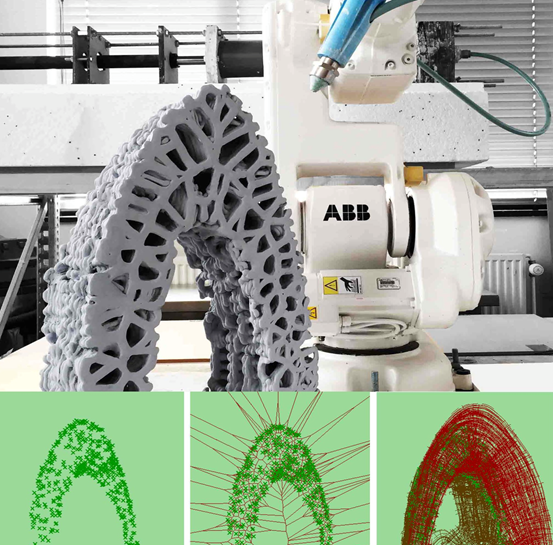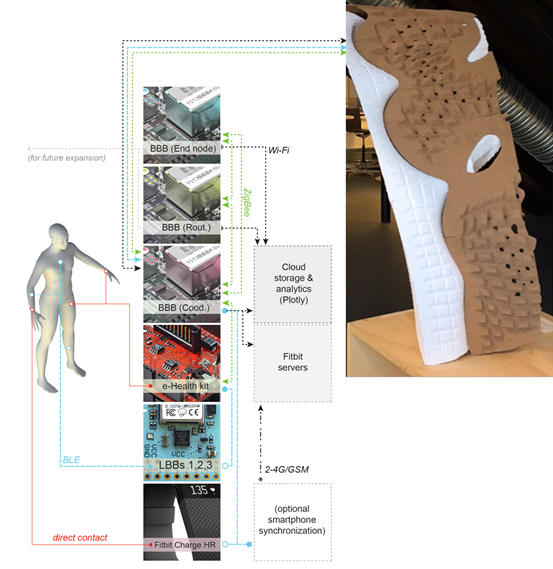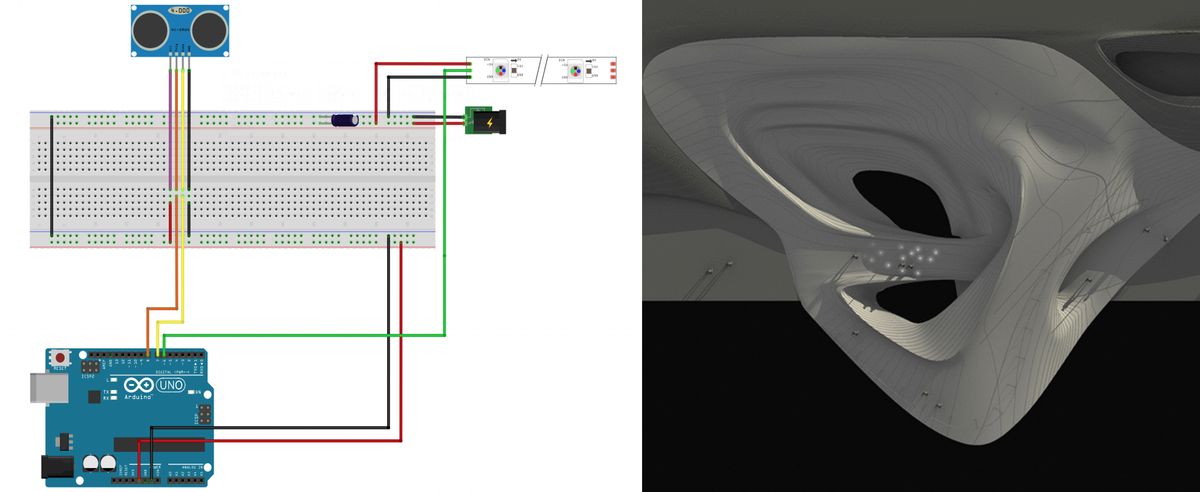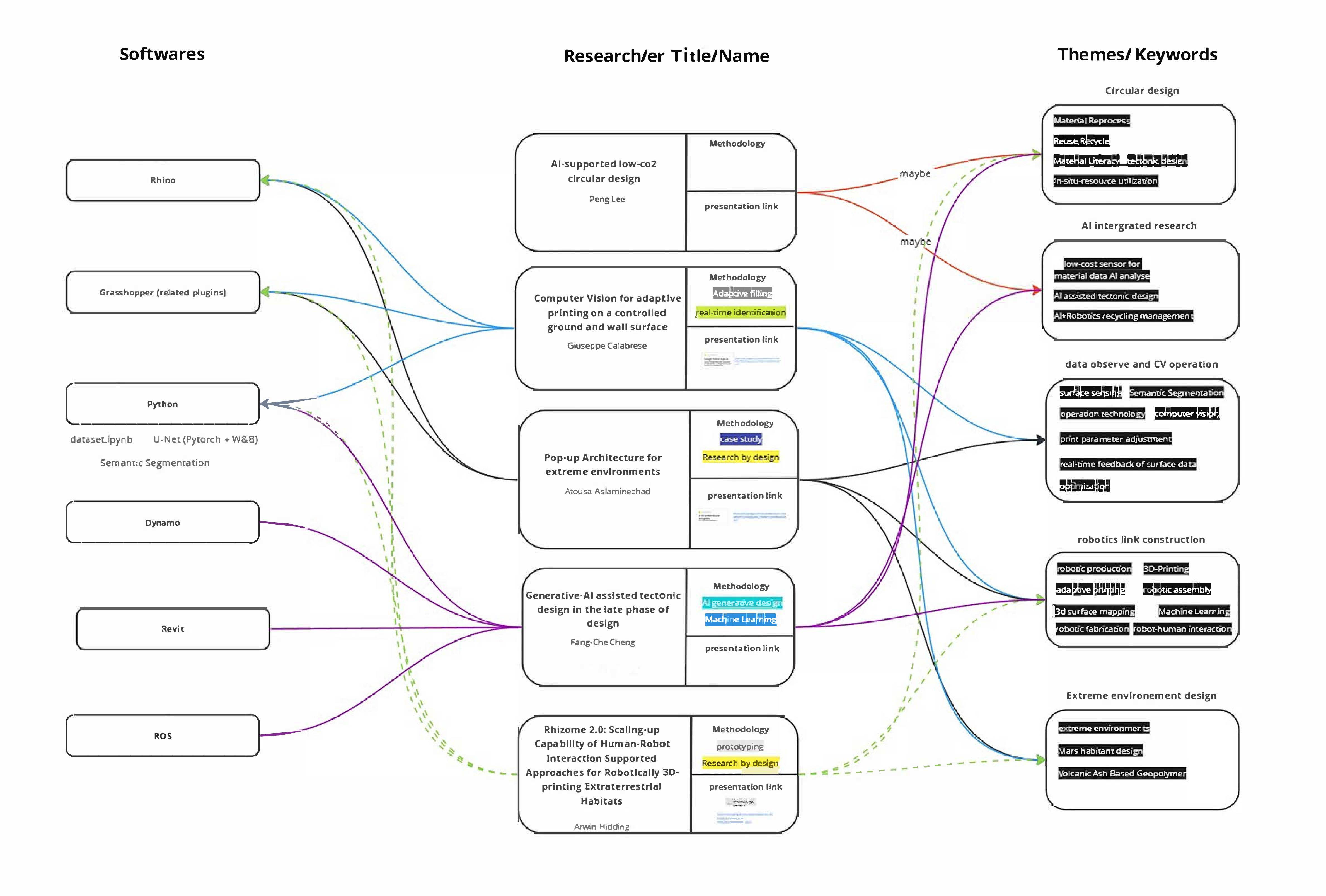RESEARCH
Robotic Building (RB) research has been focusing on advancing robotics in architecture. With help of 4TU funding RB lab have been established in 2014. Since then RB research focuses on the integration of additive and subtractive Design-to-Robotic-Production-Assembly and -Operation (D2RPA&O) chains by linking design and production with smart operation of the built environment and by advancing applications in performance optimization, robotic manufacturing, and user-driven building operation. It implies both physically built robotic environments and robotically supported building processes. When environments incorporate sensor-actuator mechanisms that enable buildings to interact with their users and surroundings in real-time, their conceptualisation and materialisation process requires D2RPA&O chains that link design to production and operation of buildings. In this context, design becomes process- instead of object-oriented, use of space becomes time- instead of program- or function-based, which implies that architects design increasingly processes, while users operate multiple time-based architectural configurations emerging from the same physical space that may physically or sensorially reconfigure in accordance to environmental and user specific needs.
D2RPA&O relies on interactions between human and non-human or cyber-physical agents and systems not only at design and production level but also at building operation level, wherein users and environmental conditions contribute to the emergence of multiple architectural configurations. While D2RP focusses on additive and subtractive production, D2RA addresses assembly and D2RO addresses building operation.
RB has an international network and long term partnerships with: TU Delft Robotics Institute, 4TU, Adaptive Environments, DIA, Architectural Robotics Lab at Cornell, LAS, Computation Group MIT, Digital Architecture and Planning at the Technical University in Vienna, Emgdotart, ABB, KUKA, 3D Robot Printing,, ESA and Vertico.
The overall goal is to address societal challenges such as (i) productivity: compared with other industries, productivity in architecture and building construction has lagged behind due to shortage of skilled labour and slow technology adoption; (ii) safety: building construction remains one of the most dangerous activities in EU involving more fatalities than any other sector in EU; (iii) environment: construction sector contributes to 20-50% on air pollution, drinking water pollution, and waste; (iv) urbanisation: rapid increase of urban population requires solutions for increasing efficiency of space use. These challenges are addressed by employing Artificial Intelligence (AI) supported D2RPA&O strategies combined with circular economy approaches in which natural and artificial agents collaborate to achieve common goals.
Several projects are work in progress or have already been completed:
Henriette Bier
EU funded projects Erasmus+ Lifelong Learning Platform: E-Archidoct and F2F Continuum (2007-10)
NL-funded project: Robotic(s in) Architecture (2010-14)
NL-funded project: Robotically-driven Construction of Buildings (2014-15)
Centre Pompidou (CP)-funded project: Imprimer le monde – Scalable porosity (2017)
NL-funded project: Variable Stiffness (2017-18)
EU-funded project: Hybrid Componentiality (2018-20)
NL-funded project: Design-to-Robotic-Production (D2RP) for Product from Landscape (2020-21)
NL-funded project: D2RP for Circular Wood (2020-22)
ESA-funded project: Rhizome 1.0: Development of an Autarkic Design-to-Robotic-Production and -Operation System for Building Off-Earth Habitats (2020-22)
NL-funded project: Rietveld Chair Reinvented (2023)
ESA-funded project: Rhizome 2.0: Scaling-up Capability of Human-Robot Interaction Supported Approaches for Robotically 3D-printing Extraterrestrial Habitats (2023-26)
Sina Mostafavi
NL-funded project: Robotically-driven Construction of Buildings (2014-15)
Centre Pompidou (CP)-funded project: Imprimer le monde – Scalable porosity (2017)
Arwin Hidding
NL-funded project: Variable Stiffness (2017-18)
NL-funded project: Design-to-Robotic-Production (D2RP) for Product from Landscape (2020-21)
NL-funded project: D2RP for Circular Wood (2020-22)
ESA-funded project: Rhizome 1.0: Development of an Autarkic Design-to-Robotic-Production and -Operation System for Building Off-Earth Habitats (2020-22)
NL-funded project: Rietveld Chair Reinvented (2023)
ESA-funded project: Rhizome 2.0: Scaling-up Capability of Human-Robot Interaction Supported Approaches for Robotically 3D-printing Extraterrestrial Habitats (2023-26)
Max Latour
NL-funded project: Design-to-Robotic-Production (D2RP) for Product from Landscape (2020-21)
NL-funded project: D2RP for Circular Wood (2020-22)
ESA-funded project: Rhizome: Development of an Autarkic Design-to-Robotic-Production and -Operation System for Building Off-Earth Habitats (2020-22)
PhD research
PhD research implemented at RB addresses Design-to-Robotic-Production-Assembly and –Operation (D2RPA&O). While D2RP, D2RA, and D2RO are treated as separate topics of research, their integration into one D2RPA&O chain is the main target.
Jelle Feringa
PhD research: Architectural Robotics
Research into architectural robotics addresses the question of how to bridge the divide between academic research and industry in the domain of architecture by investigating aspects of computational design, robotic fabrication and their impact on practice via a series of experiments and case studies. Research sub-questions related to the architectural model, geometry and implicit fabrication are investigated in relation to topology optimization, robotic hotwire and hot-blade cutting.
2022
Architectural Robotics: Bridging the Divide between Academic Research and Industry
Sina Mostafavi
PhD research: Informed Architectural Robotic Materialisation
D2RP aims to introduce strategies for the integral production of complete buildings addressing structural and climatic-environmental, programmatic and user-specific, etc. requirements. This implies that the complete building process is considered in order to identify requirements for the robotic production of material- and energy-efficient buildings. The goal is to integrate production and operation aspects from the early stages of design.
Several experiments with optimized additive and subtractive production of computationally de-rived architectural and structural topologies have been implemented at scales ranging from architec-tural (macro) to componential (meso) to material (micro) scale. By employing performance-based and generative design methods as well as robotic manufacturing, D2RP processes establish a feedback-loop between design and production of buildings components at full-scale.

Christian Friedrich
PhD research: Immediate Architecture
2021
Immediate Systems in Architecture: Continuous adaptability at the speed of human intention
Arwin Hidding
PhD research: Rhizome 2.0: Scaling-up Capability of Human-Robot Interaction Supported Approaches for Robotically 3D-printing Extraterrestrial Habitats
Proposed research aims to develop a materially, structurally, and environmentally optimised 3D printed structure by means of Robot-Robot and Human-Robot Interaction (R/HRI) supported Design-to-Robotic-Production-Assembly and Operation (D2RPA&O). It will demonstrate the scalability of the concept developed in the ESA funded Rhizome study (Fig. 1) with the aim to (a) understand whether it is applicable to large ‘real life’ construction scale and (b) outline the associated challenges and proposed solutions. It advances knowledge and technology developed so far at Technical University Delft (TUD) in collaboration with industrial partner, Vertico, for the construction of a habitat in an empty lava tube on Mars. While the subsurface habitat has natural protection from radiation and profits from lesser temperature fluctuations its construction relies on a swarm of autonomous mobile robots equipped with various end-effectors. They are deployed to mine for materials used to 3D print building components that are assembled using R/HRI supported D2RP&A methods. The assembled structure hosts a Life Support System (LLS), which relies on D2RO methods. Both, habitat construction and inhabitation are powered by an energy system combining solar- and kite-power. The ultimate goal has been to develop an autarkic HRI supported D2RPA&O system employing In-situ Resource Utilisation (ISRU) for building subsurface habitats.
Peng Lee
PhD research: AI-supported CO2-low circular design
This PhD project will enhance approaches to circularity in the architecture, engineering, and construction industry by developing an AI-supported decision model for evaluating reuse possibilities of existing buildings and the materials deployed in them.
Affiliated PhD research
Atousa Aslaminezhad
PhD research: Developing new pop-up habitats by means of computational design and robotic production
This research seeks to develop new enveloping models for pop-up habitats by computationally designing and robotically producing and operating structures that meet user requirements within specific contexts. The research investigates historical precedents and current state-of-the-art approaches to assess design performance and responsiveness to specific environmental contexts including materiality aspects.
The study will focus first on a case study in the Middle East, with the goal of identifying requirements and expanding the scope towards including Mars as the second location. It will build up on Design-to-Robotic-Production-Assembly and -Operation (D2RPA&O) and material science research in order to respond to post-disaster and emergency challenges and future habitations on Mars.
A key deliverable of this research is a novel design methodology which entails:
- design criteria as an input in order to meet the requirements for robotic production and assembly, thus it requires material science and innovation as well as intertwined structural design and mechanics knowledge;
- process and approach as development measures from design to manufacture, assembly and use;
- design, materiality, and structural performance evaluation.
Giuseppe Calabrese
PhD research: Habitability for Human Exploration of Moon and Mars
This doctoral research investigates the potential of robotics in architectural design, construction, and maintenance. Furthermore, the study intends to incorporate machine learning and artificial intelligence to optimize robotic performance and enable autonomous robotic systems to scout for materials and construct in extraterrestrial natural geological formations. The overarching objective is to explore the possibilities and limitations of this emerging field and contribute to the growing body of knowledge on the use of robotics in the built environment.
In this context, two main components are explored: habitability and in-situ resource utilization for constructing permanent infrastructures. The primary focus is on the construction of infrastructure and the recovery of materials from rocks and regolith present on the surface, or with material grown in situ, such as mycelium. This research adopts a multidisciplinary approach and closely aligns with industrial reality, utilizing innovative technologies that will be applied in space operations, an area at the forefront of human knowledge. It investigates the technological aspect of human exploration to comprehend how humans can establish and manoeuvre in remote and harsh planetary environments. Hence it aims to advance the field of robotics in architecture and construction and contributes to the development of innovative and sustainable solutions for constructing permanent infrastructure in hostile and remote environments, specifically on the Moon and Mars. The project aims to pave the way for the integration of robotic systems into the construction process and push the boundaries of human exploration beyond Earth.
Alex Binh Vinh Duc Nguyen
1st and final review 2023: Towards a Robotic Architecture that Mediates Place
Joshua Lye
1st review, 2022: Machine Learning Combinatorial Frameworks for Architecture
Gwyllim Jahn
Final review / Defence, 2022: Mixed reality fabrication
Nadja Gaudillière-Jami
Final review / Defence, 2022: Automatiser l’architecture ? Savoir-faire et calculabilité dans les pratiques des courants computationnels en architecture, 1965-2020
Jakub Tyc
1st review, 2022: Application of photogrammetry and composite voxel models for spatial knowledge encoding in the context of data-driven design
Final review / Defence, 2024: Encoding Spatial Knowledge for Data-Driven Design in Architecture Photogrammetry and Composite Voxel Models as Spatial Data Structures
Guest PhD research
Fang-Che Cheng
Ph.D. Research: RoBIM: An In-Situ Autonomous Robotics Assembly system for Digital Fabrication and Human-Robot Collaboration
The integration of Robot Operating System (ROS)with Human-Machine Collaboration (HMC) currently represents the future toward Autonomous Robotic In-Situ Assembly on Construction Sites. This research aims to present an In-Situ autonomous Robots system based on Building Information Modeling (BIM), Computer Vision (CV), and Human-Robot Interaction/Collaboration (HRI/C). Collaborative Robots can autonomously process specific building components on-site to construct structures without tagging. Using the virtual representation of objects presented in a BIM model, this system is autonomously identifying the most suitable objects in an environment through Computer Vision and Machine Learning, guiding the robot to select and manipulate the found elements to build the desired structure. The system provides a real-time Human-Robot Collaboration and Visualisation system to implement real-time error correction, presenting an implementation of comprehensive interaction and conversion rules between design information and robotic data. Hence, the research aims develop Design-Data-Robotic-Assembly (DDRA) approaches toward realizing a simple-to-deploy autonomous robotics building application, exploring new collaboration between humans and robots in intelligent construction.
Yu-Chou Chiang
PhD research: Design to Robotic Assembly
The D2RA research focusses on development of:
1. Meshless structural form-finding method
Conventional computerized form-finding methods are based on finite element methods (FEM), which have to separate i.e. divide the solving domain into discrete elements. Meshless methods are an emerging numerical approach to solve numerical problems without such division. Preliminary investigation shows that such methods can successfully solve form-finding problem for shell structure.
2. Reconfigurable assembly
Assembling is one of the most complex phases in construction. Currently, assembly methods are based on folding or unstable mechanism, which implies that the application is either constrained to developable surfaces or not self-supporting. The research is proposing a reconfigurable bi-stable mechanism. Preliminary explorations suggest that this approach can overcome shortcomings of conventional methods. Prototypes including self-supporting dome and saddle were produced in the first year as proof of concept. These were 3D-printed in flat configurations then transformed into double-curved forms.
3. Multi-robot and human-robot collaboration
Technology for multi-robot and human-robot applied on construction site are not fully developed yet. Considering reconfigurable assembly, this research will explore how a team of robots and builders can concurrently assemble a shell on a flat ground before reconfiguring the assemblage to its curved state. In this scenario, robots and builders can directly access the working pieces without extra lifting equipment (e.g., gantry, tower crane, scissors lift).
Alex Liu Cheng
PhD research: Design, development, and implementation of a high-resolution intelligence framework based on Design to Robotic Production & Operation (D2RP&O) principles and methods
This PhD research situates computational intelligence in the form of Cyber-Physical Systems (CPSs) within the Adaptive Architecture discourse. The objectives are framed with respect to both a general and a specific scope. In the general scope, the proposal aims to develop a theoretical, methodological, technical, and technological framework for (a) the design, development, and seamless integration of cost-effective intelligent systems (physical and computational) into the built-environment; and (b) the design and robotic fabrication of corresponding optimized components to support and be supported by said systems, both via Design to Robotic Production & Operation (D2RP&O) principles and methods. The processes involved in the development of such a framework, as an alternative to existing intelligent frameworks, bear methodological consequences for certain societal challenges such as inefficient distribution and use of built-space, adaptation to rapid densification caused by demographic change, and to population migrations caused by catastrophic events, etc. In the specific scope, the proposal focuses on the deployment of this framework within the Ambient Intelligence (AmI) and Ambient Assisted Living (AAL) discourse, which aims to address an unavoidable and particularly pressing age-related demographic challenge. The expected benefits yielded by the proposed framework are consequential across scopes as they satisfy and extend beyond AAL and Activities of Daily Living (ADLs) desiderata.

Milica Pavlovic
PhD research completed 2020: Design tools for managing User Experience within systems of Ambient Intelligence
The research aims to contribute to the field of User Interaction and Experience Design, by providing a design methodology and toolset to be applied within the emerging projects for systems of Ambient Intelligence (AmI). This is to say that the research has identified a necessity for expanding the current practices in the UX field by supporting them with the set of tools to be used as a backbone for structured design processes. The need derived from the nature of ongoing practices observed within the industries of interest, as well as the research streams in the academic field. Furthermore, meaningful contribution is targeted also towards the other fields that practice design of such systems, and these are Software Engineering, Human-Computer Interaction, Artificial Intelligence and Machine Learning, Architecture, and others. The contribution of the research expands on diverse practiced Design sectors of nowadays and proposes a convergence of the same towards the approach of designing for experiences and user values. In this context, it is to state that the research aims for verifying and updating the tools to be used for envisioning and designing AmI systems, thus supporting the definition of Ambient UX practices. Potentially, the research will provide a base structure for developing a software to be employed in the practices, for supporting creation of a common language between all the parties and stakeholders involved in the design project.



